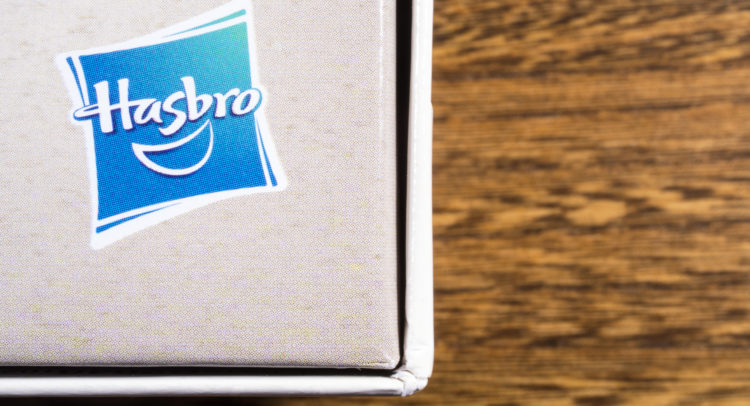For many consumers worldwide, Hasbro (HAS) is a company that needs no introduction. The global entertainment conglomerate provides consumer products, including games and toys, as well as gaming and entertainment solutions.
Its world-famous portfolio of brands includes names like Nerf, Monopoly, Dungeons & Dragons, Power Rangers, and others. The company’s target audience includes children and families primarily.
Recently, the company had a change in the helm, announcing the appointment of Christian (Chris) Cocks as Chief Executive
Officer and a member of the Board of Directors, effective February 25, 2022. The management change aims to reassure investors and analysts that mending financial performance shortcomings (explored below) is a high-level priority for Hasbro.
Stock Performance
Following through on mixed signals in terms of financial performance, Hasbro’s stock has not done much in the last three years. In fact, during a prolonged bull market for U.S. equities, HAS has seen a -19.6% three-year price return.
A sharp COVID-19-related decline phased the company in 2020, only to be eventually followed by the sell-off the broader market is currently enduring, just as the stock was struggling to reach pre-pandemic levels.
Currently, Hasbro trades about -24% from 52-week highs, at $79.01 per share. This represents an $11 billion market capitalization, while the company also pays a relatively attractive 3.5% dividend yield.
Financial Achievements and Struggles
After observing the stock’s trajectory over the last few years, most analysts and investors could logically anticipate it matches a mediocre financial performance. In fact, while some progress has been made in certain areas, its financial performance over the last five years has been inadequate for the most part.
Even though revenue has increased since 2017 at a CAGR of 5.13%, earnings have decreased by 8.10%, indicating major operating inefficiencies and profitability concerns. Despite declining a bit, gross margins have stayed above 50% for some time, signaling that products and services bring sufficient room for profits.
Operating expenses and interest payments appear disproportionately large compared to sales, causing bottom-line profitability to struggle. As a result, net margins have hovered below the 10% threshold, dropping to around 6% recently.
Free cash flow (FCF) generation has somewhat fluctuated, yet delivering much more promising news compared to earnings as of recently. In 2021, FCF amounted to $685 million, compared to $429 million in net income. However, given the non-recurring nature of many reported cash flow items, long-term sustainable cash flow production still is a concern.
On the balance sheet side, Hasbro maintains a large cash stockpile of around $1 billion, and liquidity is, by most accounts, strong. The long-term debt build-up that has been noticed over the past few years has finally been interrupted in 2021, with debt actually decreasing for the first time since 2012.
Therefore, the firm’s capital structure and long-term survivability prospects are improving. That said, still, at $4 billion (more than one-third of the market cap), its leverage remains a concern, mainly because of the interest payments it requires, which are hurting profitability.
The Dividend
One aspect of the argument for Hasbro’s stock for the past few years has been its dividend. Currently, the stock offers a 3.5% yield, which is more than double the market average. Hasbro’s dividend growth record has been moderately pleasing as well. To be more specific, dividend distributions have grown at five and 10-year CAGRs of 5.46% and 8.1%.
On a more recent basis, with a three-year CAGR of 2.16%, growth seems to be slowing significantly. For the past year, dividends have increased by only 1.74%. For the foreseeable future, analysts expect minimal dividend increases as profitability struggles persist. Moreover, with net income generation struggling over the past five years, dividend safety also comes into question.

Valuation
With multiples that a few months ago would appear attractive, as the market rerates and continues its downside trajectory, that is just not the case anymore. Across the board, stocks are getting inexpensive, and the consumer discretionary sector (where Hasbro operates) is no exception.
As the sector carries an average P/E of 10x, Hasbro’s 17x multiple appears relatively unappealing, especially considering the company’s profitability struggles. A price-to-sales ratio of 1.75x points to a similar conclusion, as the sector trades at an average of 0.8x.
That is not necessarily to say that HAS is overvalued, but rather, given the performance metrics of the company and the current state of the stock market, there are arguably better value propositions available.
Wall Street’s Take
Turning to Wall Street, Hasbro has a Strong Buy rating based on six Buys, two Holds, and zero Sell ratings assigned over the past three months. The average Hasbro price forecast of $109 represents 38% upside potential, with a high price forecast of $128 and a low forecast of $85.

Conclusion
In the current state of the market, many quality companies can be found trading at inexpensive valuations. Unfortunately, despite some positive characteristics, like a strong and successful brand and moderate revenue growth, Hasbro appears to not make the cut, based on financial performance, that would put the company on the no-brainer Buy list.
















